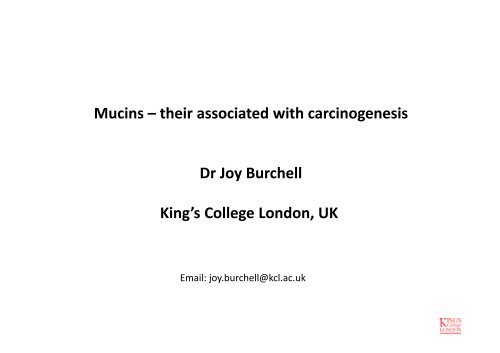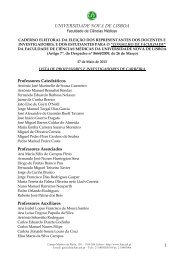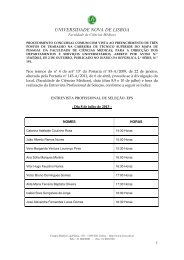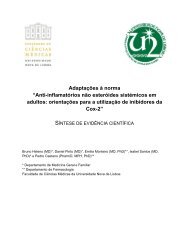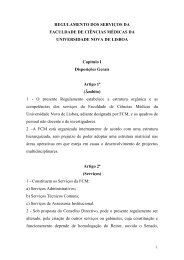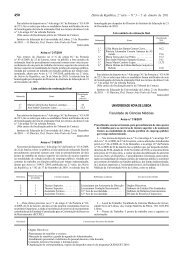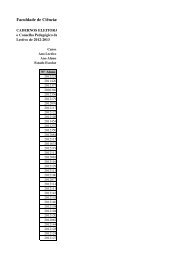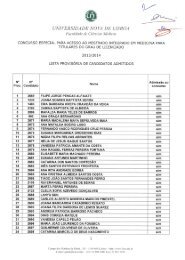Mucins – their associated with carcinogenesis Dr Joy Burchell King's ...
Mucins – their associated with carcinogenesis Dr Joy Burchell King's ...
Mucins – their associated with carcinogenesis Dr Joy Burchell King's ...
You also want an ePaper? Increase the reach of your titles
YUMPU automatically turns print PDFs into web optimized ePapers that Google loves.
<strong>Mucins</strong> <strong>–</strong> <strong>their</strong> <strong>associated</strong> <strong>with</strong> <strong>carcinogenesis</strong><br />
<strong>Dr</strong> <strong>Joy</strong> <strong>Burchell</strong><br />
King’s College London, UK<br />
Email: joy.burchell@kcl.ac.uk
Learning objectives<br />
•Understanding of the structure of <strong>Mucins</strong><br />
•Understanding <strong>their</strong> glycosylation structure<br />
•To become familiar <strong>with</strong> <strong>their</strong> role in <strong>carcinogenesis</strong><br />
Changes in expression<br />
Changes in glycosylation<br />
Relationship to tumour initiation and progression
Understanding of the structure of <strong>Mucins</strong><br />
•They are the major glycoprotein in mucus and give<br />
mucus its viscosity.<br />
•They have a protective function, keeping unwanted<br />
;<br />
substances and micro-organisms at bay, while at the<br />
same time mediating specific interactions.<br />
•<strong>Mucins</strong> are large glycoproteins that are present at the<br />
interface between many epithelium and <strong>their</strong> external<br />
environment.
Understanding of the structure of <strong>Mucins</strong><br />
•Large molecular weight glycoproteins<br />
•More than 50% carbohydrate<br />
;<br />
•Oligosaccharide side chains are linked through oxygen<br />
to serine or threonine<br />
•Contain a domain of tandemly repeated amino acids rich<br />
in serine, threonine and proline.<br />
•<strong>Mucins</strong> can be either membrane bound or secreted
Understanding of the structure of <strong>Mucins</strong><br />
Have a general “bottle<br />
brush” structure<br />
Oligosaccharide<br />
;<br />
Polypeptide
Mucin Membrane/secreted Chromosome<br />
MUC1 M 1q21<br />
MUC2 S 11p15<br />
MUC3A/B M 7q22<br />
MUC4 M 3q29<br />
MUC5AC S 11p15<br />
MUC5B S 11p15<br />
MUC6 S 11p15<br />
MUC7 S 4q13-q21<br />
MUC8 S 12q24<br />
MUC11 M 7q22<br />
MUC12 M 7q22<br />
MUC13 M 3q13<br />
MUC15 M 11p14.3<br />
MUC16 M 17q21<br />
MUC17 M 7q22<br />
MUC18 M<br />
MUC19 S 12<br />
MUC20 M 3q21<br />
;
Understanding of the structure of <strong>Mucins</strong><br />
Sizes of tandem repeats<br />
MUC1 20 amino acids<br />
MUC2 23 amino acids<br />
MUC3A/B 17 amino acids<br />
MUC4 16 amino acids<br />
MUC5AC 8 amino acids<br />
;<br />
MUC5B 87 amino acids<br />
MUC6 169 amino acids<br />
MUC7 22 amino acids<br />
MUC9 15 amino acids<br />
MUC11/12 28 amino acids<br />
MUC16 156 amino acids<br />
MUC1, MUC2, MUC3, MUC4, MUC5AC, MUC6, MUC7 all show allelic<br />
polymorphism. MUC5C does not.
Understanding of the structure of <strong>Mucins</strong><br />
Allelic variation<br />
MUC1, MUC2, MUC3A/B, MUC4, MUC5AC, MUC6, MUC7<br />
all show allelic polymorphism.<br />
MUC1: the number of tandem repeats in MUC1 can vary<br />
between 20-150 depending on the individual.<br />
M ; F<br />
Polymorphisms seen at the DNA, RNA and protein
Extracellular Membrane<br />
MUC2<br />
MUC5AC<br />
MUC5B<br />
MUC6<br />
Understanding of the structure of <strong>Mucins</strong><br />
MUC19<br />
MUC7 (monomer)<br />
MUC8 ?<br />
Epithelial mucins<br />
11p15<br />
Multi-mers<br />
;<br />
MUC1<br />
MUC3A<br />
MUC3B<br />
MUC4<br />
MUC12<br />
MUC11<br />
MUC13<br />
MUC15<br />
MUC16<br />
MUC17<br />
MUC18<br />
MUC20<br />
Selectin ligands:<br />
PSGL-1<br />
CD34 (GlyCAM-<br />
1)
Understanding of the structure of <strong>Mucins</strong><br />
Epithelial mucins<br />
Secreted Membrane<br />
MUC2<br />
MUC5AC<br />
MUC5B<br />
MUC6<br />
MUC19<br />
MUC7 (monomer)<br />
MUC8<br />
11p15<br />
; Multi-mers<br />
MUC1<br />
MUC3A<br />
MUC3B<br />
MUC4<br />
MUC12<br />
MUC13<br />
MUC15<br />
MUC16<br />
MUC17<br />
MUC18<br />
MUC20<br />
However, MUC1 has now been shown to be expressed<br />
on activated T cells and matured dendritic cells but the<br />
levels are low
Understanding of the structure of <strong>Mucins</strong><br />
;
Understanding of the structure of <strong>Mucins</strong><br />
Membrane mucins<br />
MUC1, MUC3A, MUC3B, MUC4, MUC12, MUC13 and<br />
MUC16 all appear to be post translationally cleaved into 2<br />
peptides in the ER.<br />
However, they stay together as they move through the Golgi<br />
and when the MUC is inserted into the membrane.<br />
O-linked oligossacharide<br />
Polypeptide<br />
;<br />
Cell membrane
Understanding of the structure of <strong>Mucins</strong><br />
MUC1<br />
;<br />
Taken from Kufe, Oncogene 2012:1-9
Understanding of the structure of <strong>Mucins</strong><br />
Secreted <strong>Mucins</strong><br />
;<br />
N terminal D domains homologous to domains in VWF, rich in<br />
cystine, involved in intra and inter molecular bonds.<br />
C terminal C and CK cys-rich domains also have some homology<br />
to similar domains in VWF.
Understanding of the structure of <strong>Mucins</strong><br />
The structure of secreted mucins<br />
;<br />
Schematic representation of the secreted mucins MUC2, MUC5B, MUC5AC,<br />
and MUC6 localized on the chromosome 11 in p15.5. The domains D1, D2, D3,<br />
D', D4, B, C, and CK (cystin knot) show a high level of similarity <strong>with</strong> the<br />
respective domains of the pro-von Willebrand factor. The T/S/P domains are the<br />
domains rich in serine, threonine, and proline amino acid residues. Cys are<br />
domains rich in cystein amino acid residues, and PS is the peptide signal.
Understanding of the structure of <strong>Mucins</strong><br />
Assembly of secreted mucins<br />
1.Translation of the monomer<br />
2.The formation of dimers thro’<br />
COOH CK domains and Nglycosylation.<br />
ER<br />
4. O-glycosylation of the dimer.<br />
5. The formation of multimers thro’<br />
the NH 2 D-domains. Golgi.<br />
6.Translocation into secretory<br />
granules.<br />
7&8.Transport vesicles and mucin<br />
granules secreted by constitutive<br />
and regulatory exocytotic<br />
pathways.
Understanding of the structure of <strong>Mucins</strong><br />
Expression<br />
Membrane<br />
MUC1 most simple epithelial cells (activated T cells and DCs)<br />
MUC3A intestines, gall bladder and hepatocytes<br />
MUC3B intestines<br />
MUC4 trachea, bronchus, colon, breast<br />
MUC11/12 different tissues<br />
MUC16 ocular surfaces, cervical secretions, respiratory tract.<br />
Secreted<br />
MUC2 colon, small intestine, bronchus, trachea.<br />
MUC5AC stomach, respiratory tract<br />
MUC5B stomach, respiratory tract<br />
MUC6 stomach, colon, gallbladder, endocervix<br />
MUC7 sublingual salivary gland<br />
MUC8 tracheal, nasal<br />
;
Learning objectives<br />
•Understanding of the structure of <strong>Mucins</strong><br />
•Understanding <strong>their</strong> glycosylation structure<br />
•To become familiar <strong>with</strong> <strong>their</strong> role in carcinogensis<br />
;<br />
Changes in expression<br />
Changes in glycosylation<br />
Relationship to tumour initiation and progression
Mucin-type O-linked glycosylation<br />
•Sugars are added to serine and threonine and are<br />
linked through oxygen (O-linked).<br />
•No consensus peptide sequence for the addition of the<br />
sugars has been identified.<br />
;<br />
•Sugars are added singly and sequentially.<br />
•Each addition is catalysed by a glycosyltransferase.<br />
•The first sugar to be added is GalNAc.<br />
•Initiation of O-linked glycosylation occurs in the Golgi<br />
apparatus.<br />
•Several different “core” structures are formed,<br />
depending on the tissue, and these can be extended.
Mucin-type O-linked glycosylation<br />
First sugar to be added N-acetylgalactosamine GalNAc<br />
UDPGalNAc + Thr/Ser-R<br />
UDP + GalNAc-Thr/Ser-R<br />
Large family of polypeptide GalNAcTs that can catalyse this reaction<br />
;
Mucin-type O-linked glycosylation<br />
ppGalNAcTs<br />
•So far around 20 ppGalNAcTs have been cloned.<br />
•Distinct but overlapping specificities.<br />
•The tandem repeat of MUC1 has been used as a model<br />
㜰<br />
peptide to study the substrate specificity and kinetics of a<br />
number of ppGalNAcT.<br />
•Within each TR of MUC1 there are five potential sites for<br />
O-linked glycosylation. To get all the sites glycosylated<br />
require 3 ppGalNAcTs.<br />
•Some ppGalNAcTs required a glycosylated substrate
Structure of the MUC1 mucin<br />
Signal<br />
127aa<br />
Tandem repeat domain<br />
㜰<br />
HGVTSAPDTRPAPGSTAPPA<br />
The tandem repeat of MUC1, <strong>with</strong> five O-linked<br />
glycosylation sites has been used to determine the<br />
specificity of some polypeptide GalNAc-Ts<br />
TM
Mucin-type O-linked glycosylation<br />
ppGalNAcTs can be distributed throughout the Golgi.<br />
Shown by tagging ppGalNAcTs <strong>with</strong> immuno-reactive<br />
epitope and EM using gold labelled second antibody.<br />
<br />
For review see: Gill, Clausen<br />
and Bard 2010 Location,<br />
location, location: new insights<br />
into O-GalNAc protein<br />
glycosylation.<br />
Trends in Biology
Basic structure of O-glycans<br />
Core Backbone Peripheral<br />
Lactosamine <br />
chains<br />
Terminal epitopes,<br />
αlinked
Common backbone structure on mucins<br />
Core 1<br />
Core2<br />
Core 3<br />
Core 4<br />
;
Formation of core 1 by β1,3GalT<br />
T synthase requires a molecular chaperone for<br />
activity<br />
ββββ1,3 GalT also known as T synthase because it catalyses the<br />
formation of core 1 also known as T or TF.<br />
<br />
(GalNAc Galβ1-3GalNAc) only GT that can catalyse this reaction<br />
Cosmc is located in the ER and is required for the correct folding and<br />
activity of T synthase in the Golgi. Private chaperone, only binds to T<br />
synthase.<br />
Dysfunction of Cosmc leads to the expression of the Ser/Thr-GalNAc<br />
also known as the Tn antigen<br />
J Biol Chem. 2010 Jan 22;285(4):2456-62.
Extension of the core structures
Learning objectives<br />
•Understanding of the structure of <strong>Mucins</strong><br />
•Understanding <strong>their</strong> glycosylation structure<br />
•To become familiar <strong>with</strong> <strong>their</strong> role in carcinogensis<br />
㿀<br />
Changes in expression<br />
Changes in glycosylation<br />
Relationship to tumour initiation and progression
<strong>Mucins</strong> and malignancy<br />
Change in the expression of mucins<br />
<strong>Mucins</strong> can be aberrantly glycosylated in<br />
㷰<br />
tumours resulting in:<br />
•Change of the number of sites<br />
•Change in the length of the sugar sidechains
<strong>Mucins</strong> and malignancy<br />
<strong>Mucins</strong> can be dramatically upregulated e.g MUC1 is<br />
upregulated 10-100 fold in breast carcinomas compared to<br />
the expression in the normal mammary gland.<br />
Ϛ
N<br />
<strong>Mucins</strong> can be over expressed in cancers<br />
MUC1 MUC5B MUC8<br />
C<br />
N<br />
េ◌ៀϜ<br />
MUC1, MUC5B and MUC8 expression in normal endometrial tissue<br />
(N) and endometrial cancers (Lau et al Am J Clin Pathol 2004;122:61-69)<br />
C<br />
N<br />
C
Changes in the glycosylation<br />
Change in the number of sites.<br />
•MUC1 purified from human milk has been shown to<br />
have, on average 2.5 sites glycosylated per tandem<br />
repeat.<br />
•MUC1 purified from a breast carcinomas cell line<br />
딀͵<br />
has on average 4.5 sites glycosylated per tandem<br />
repeat.<br />
•Analysis of the sites occupied in other breast<br />
carcinoma cells shown a range from 2.5-5. This may<br />
reflect the the inability of ppGalNAcTs to get access<br />
to <strong>their</strong> site of glycosylation due to the length of<br />
adjacent chains that have already been<br />
glycosylated.
One mechanism may be the activation of Src, often seen in<br />
tumours, results in a relocation of ppGalNAcTs from the Golgi<br />
to the ER<br />
߰Ҕ<br />
This results in an increased density of glycosylation, increase in<br />
number of sites glycosylated<br />
Gill et. al. 2010 J. Cell Biol. 189, 843-858
Increased number of sites<br />
However other mechanisms may be related to the<br />
ditruption of the Golgi often seen in advance cancer<br />
cells<br />
and/or<br />
The decrease length of glycans on adjacent sites not<br />
߰Ҕ<br />
inhibiting the glycosylation of other sites<br />
Distribution of polypeptide<br />
GalNAcTs is seen<br />
throughout the Golgi
Changes in the length of the side chains<br />
Pathway of O-linked glycosylation of MUC1 in the<br />
mammary gland<br />
T epitope<br />
Tn epitope<br />
C2GnTI<br />
β1,3GalT<br />
Galβ1,3GalNAc<br />
β1,6<br />
GlcNAc<br />
HGVTSAPDTRPAPGSTAPPA<br />
ppGalNAcTs<br />
Galβ1,3GalNAc<br />
GalNAc-αSer/Thr<br />
ϝ<br />
ST3Gal-I<br />
SAα2,3Galβ1,3GalNAc<br />
SAα2,3Galβ1,3GalNAc<br />
α2,6<br />
SA<br />
ST6GalNAcI<br />
STn epitope<br />
SAα2,6GalNAc<br />
ST epitope
α3<br />
α6<br />
α<br />
Sialyl-Tn<br />
β3<br />
α<br />
Sialyl-T<br />
S/T<br />
S/T<br />
Cancer Cell<br />
ST6GalNAc I<br />
Tn<br />
Peptide<br />
α<br />
S/T<br />
Normal Cell<br />
ST3Gal -I α * C2GnT<br />
α S/T<br />
β3<br />
Sialylation Sialylation,<br />
elongation<br />
Core 1<br />
ppGAT<br />
C1GalT<br />
S/T<br />
β6<br />
β3<br />
β4GalT,<br />
sialylation,<br />
elongation<br />
GalNAc Gal GalNAc Neu5Ac<br />
Core 2
SM3 HMFG2<br />
泐͵
Change in O-linked glycans attached to MUC1 in breast<br />
cancer: SM3 binding is blocked by long O-glycans<br />
SM3<br />
-ve<br />
HGVTSAPDTRPAPGSTAPPA<br />
SM3<br />
Common event as 90% breast carcinomas react <strong>with</strong> SM3:<br />
Must be advantageous to the tumour in some way?<br />
ͺ<br />
Malignancy<br />
SM3<br />
+ve
Mechanisms responsible for the changes in glycan<br />
side chains<br />
Mutations in cosmc<br />
Changes in the expression of glycosyltransferases<br />
洠͵
Mechanisms responsible for the aberrant O-linked<br />
glycosylation.<br />
Mutations in Cosmc results in the expression of Tn and if<br />
ST6GalNAc-T expressed STn<br />
Ju, T. et al. Cancer Res 2008;68:1636-1646<br />
Copyright ©2008 American Association for Cancer Research<br />
ͺ
Dysfunctional Cosmc is not the main mechanism<br />
for Tn expression in breast cancer<br />
浰͵
Activation of Src, often seen in tumours, results in a<br />
relocation of ppGalNAcTs from the Golgi to the ER<br />
ͺ<br />
This results in an increased density of glycosylation, increase in<br />
number of sites glycosylated<br />
Gill et. al. 2010 J. Cell Biol. 189, 843-858<br />
As high density of O-GalNAc may hinder T synthase and C2GnT <strong>–</strong><br />
result in shorter side chains and expression of Tn, STn or core 1
Mechanisms responsible for the aberrant Olinked<br />
glycosylation. Changes in expresssion of<br />
glycosyltransferases 1<br />
Ser/Thr-GalNAc SAα2,6GalNAc<br />
The sialyl Tn epitope<br />
Expressed by about 30% of breast cancers<br />
100% correlation between the expression of the glycan<br />
and the glycosyltransferase ST6GalNAc-I<br />
(Sewell et al 2005 JBC)<br />
淀͵<br />
Expression is the result of turning on of the sialyltransferase<br />
ST6GalNAc-I
In breast carcinomas, expression of STn correlates <strong>with</strong><br />
ST6GalNAc-1 expression<br />
BrCa Case Sialyl Tn Northern RT-PCR<br />
13 Negative Negative Negative<br />
3 Negative Negative Not analysed<br />
20 Negative Negative Negative<br />
26 Weak Positive Negative Positive<br />
2 Negative Negative Negative<br />
12 Negative Negative Negative<br />
14 Negative Negative Not analysed<br />
21 Negative Negative Negative<br />
18 Negative Negative Negative<br />
28 Positive Positive Not analysed<br />
7 Negative Negative Negative<br />
5<br />
23<br />
Negative<br />
Weak Positive<br />
Negative<br />
ͺ<br />
Negative<br />
Negative<br />
Positive<br />
19 Negative Negative Not<br />
9 Negative Negative Not analysed<br />
29 Positive Positive Not analysed<br />
8 Negative Negative Not analysed<br />
15 Negative Negative Negative<br />
16 Negative Negative Negative<br />
6 Negative Negative Negative<br />
11 Negative Negative Negative<br />
17 Negative Negative Negative<br />
27 Weak Positive Negative Positive<br />
1 Positive Negative Positive<br />
4 Weak Positive Negative Positive<br />
22 Positive Positive Not analysed<br />
10 Positive Positive Positive<br />
24 Positive Positive Positive<br />
25 Negative Negative Negative
Expression of ST6GalNAc-I over-rides existing Oglycosylation<br />
in T47D cells<br />
<br />
Myc<br />
ST6GalNAc-1<br />
Anti-STn
Expression of ST6GalNAc-I over-rides existing Oglycosylation<br />
in MTSV1-7 cells that express core 2<br />
glycans<br />
Myc tagged ST6GalNAc-I STn expression<br />
暀͵<br />
Infers located early in the Golgi <strong>–</strong> mapping by electronmicroscopy<br />
using tagged ST6GalNAc- I and immuno-gold shows the GT is<br />
located throughout the Golgi
Mechanisms responsible for the aberrant Olinked<br />
glycosylation Changes in expresssion<br />
of glycosyltransferases<br />
The sialyl T epitope: SAα2,3 Galβ1,3GalNAc<br />
Common O-glycan, often found in normal cells<br />
But not found on MUC1 when it is expressed by normal cells<br />
Increased expression results from an over-expression of<br />
ST3Gal-I
ST3Gal-I mRNA expression by breast tissues (in situ<br />
hybridisation)<br />
ͺ
ST3Gal-I expression is up-regulated and <strong>associated</strong> <strong>with</strong><br />
grade<br />
Benign Grade I<br />
Grade III<br />
SCORE % AND INTENSITY<br />
6<br />
5<br />
4<br />
3<br />
2<br />
1<br />
0<br />
BENIGN<br />
1<br />
Grade I Grade II Grade III
ST3Gal-I and C2GnT1 compete for a common<br />
substrate<br />
Galβ1-3GalNAc<br />
ST3Gal-I C2GnT1<br />
SAα2,3 Galβ1-3GalNAc Galβ1-3GalNAc<br />
β1,6<br />
GlcNAc<br />
쉐Ϥ
What is the relevance of over-expression of<br />
mucins and the aberrant O-glycosylation?<br />
Immunotherapy<br />
Cancer-<strong>associated</strong> antigenically distinct<br />
Induce a humoral response<br />
Change in glycosylation could alter uptake by and<br />
breakdown by APCs. Through lectin interactions?<br />
ͺ<br />
Can be used as target for T cells that express chimeric<br />
antigen receptors (CAR)<br />
Used as a biomarker?<br />
Biological relevance to the tumour?<br />
Very common event<br />
Murine tumours expressing human MUC1 carrying sialyl T<br />
grow faster than tumours expressing MUC1 carrying core 2<br />
glycans in MUC1 TG mice
Learning objectives<br />
•Understanding of the structure of <strong>Mucins</strong><br />
•Understanding <strong>their</strong> glycosylation structure<br />
•To become familiar <strong>with</strong> <strong>their</strong> role in carcinogensis<br />
쉐Ϥ<br />
Changes in expression<br />
Changes in glycosylation<br />
Relationship to tumour initiation and progression
What is the relevance of over-expression of<br />
mucins and the aberrant O-glycosylation?<br />
Immunotherapy<br />
Cancer-<strong>associated</strong> antigenically distinct<br />
Induce a humoral response<br />
Change in glycosylation could alter uptake by and<br />
breakdown by APCs. Through lectin interactions?<br />
ͺ<br />
Can be used as target for T cells that express chimeric<br />
antigen receptors (CAR)<br />
Used as a biomarker?<br />
Biological relevance to the tumour?<br />
Very common event<br />
Murine tumours expressing human MUC1 carrying sialyl T<br />
grow faster than tumours expressing MUC1 carrying core 2<br />
glycans in MUC1 TG mice
Cancer cells lose <strong>their</strong> polarity<br />
Carraway et al Future Oncol. 2009 December; 5(10): 1631<strong>–</strong>1640.<br />
ͺ
Loss of cell polarity in Cancer<br />
Upregulation of MUC1 and loss of cellular polarity allows<br />
interaction <strong>with</strong> EGFR leading to increased signaling<br />
쉐Ϥ
Changes in glycosylation of MUC1 in breast cancer<br />
Increased expression of ST3Gal-I can promote tumorigenesis<br />
Picco et al 2010 Glycobiology<br />
ͺ
MUC1 carrying a tumour <strong>associated</strong> glycan can interact<br />
<strong>with</strong> galectin 3<br />
TF or T antigen Galβ1,3GalNAc<br />
Galectin 3 - one of the galectin family of galactose binding proteins<br />
Concentration of galectin 3 increased in the sera of breast cancer patients<br />
(Yu et al 2007 J Biological Chemistry 283:773-781)<br />
ͺ
MUC1 carrying sialylated tumour <strong>associated</strong> glycans<br />
could interact <strong>with</strong> Siglecs<br />
SAα2,3Galβ1,3GalNAc<br />
Siglecs are lectins on the surface of cells of the immune<br />
system that bind sialic acid<br />
װ<br />
MUC1 has been shown<br />
to bind to Siglec1<br />
(sialoadhesin)<br />
Nath et al Immunology,<br />
1999, 98: 213-219 and<br />
Siglec 3 (unpublished<br />
results).
Aberrant glycosylation of MUC1 may enhance<br />
uptake by lectins on APCs<br />
MUC1 carrying Tn tumour <strong>associated</strong> glycan can interact <strong>with</strong> MGL<br />
MGL is a lectin expressed on immature dendritic cells that can bind GalNAc<br />
MGL transfected cells Dendritic cells<br />
װ<br />
(Napoletano et al 2007 Journal of<br />
Immunology, 67:8358-8367)
However things are not also ways that simple!!!!<br />
Around 75% of breast cancers are defined as ER-positive.<br />
This means they express the estrogen receptor and the<br />
hormone estrogen drives the proliferation of the tumour.<br />
Around 25% are therefore ER negative and these seem to<br />
have have a different pathway of mucin glycosylation<br />
װ
Mucin glycosylation of ER positive and ER<br />
negative breast cancers<br />
ER+ve<br />
tumours<br />
ER-ve<br />
tumours<br />
α2-3<br />
β1-3<br />
Expression of SLe x<br />
α<br />
R<br />
ST3Gal-I<br />
fucosyltransferases and<br />
sialyltransferase<br />
β1-6 α<br />
β1-3<br />
Core 1<br />
R<br />
β1-3<br />
װ<br />
α<br />
β1-6 α<br />
β1-3<br />
α<br />
R<br />
R<br />
C2GnT1<br />
R<br />
C2GnT1<br />
Core2<br />
R<br />
Core2<br />
β1-6 α<br />
β1-3<br />
Elongation<br />
from the<br />
Gal and<br />
GlcNAc<br />
GalNAc Gal GlcNAc Neu5Ac<br />
R<br />
Normal<br />
mammary<br />
epithelium<br />
ER-ve tumors are also more likely to carry more sLe X antigen
Analysed sLe x expression by Breast cancers<br />
352 consecutive primary human breast carcinomas were stained for the<br />
expression of sLe x (antibody HECA-452)<br />
Julien et al Cancer Res 2011 Cancer Research<br />
װ
But it is even more complicated as some ER+ve can<br />
express sLex!!<br />
Julien et al Cancer Res 2011<br />
װ
sLe x<br />
Changes in glycosylation may promote metastasis<br />
E-selectin is constitutively<br />
expressed in the<br />
microvasculature of bone<br />
marrow<br />
Taken from Sackstein 2009 Immunological Reviews Vol. 230: 51<strong>–</strong>74<br />
װ
Within the ER positive cancers high levels of sLex<br />
expression was <strong>associated</strong> <strong>with</strong> bone metastasis<br />
ER+ve ER-ve<br />
p=
Changes in mucin glycosylation and<br />
the affects on tumour progression is<br />
complicated!!<br />
װ
From this lecture it is hope that you now know<br />
•The basis of the structure of <strong>Mucins</strong><br />
•The glycosylation of MUC1 in the normal mammary gland and breast<br />
carcinomas<br />
•Have an idea of the role of mucins in <strong>carcinogenesis</strong><br />
Changes in expression<br />
Changes in glycosylation<br />
Relationship to tumour initiation and progression<br />
װ
Thanks you for listening!!!<br />
װ


